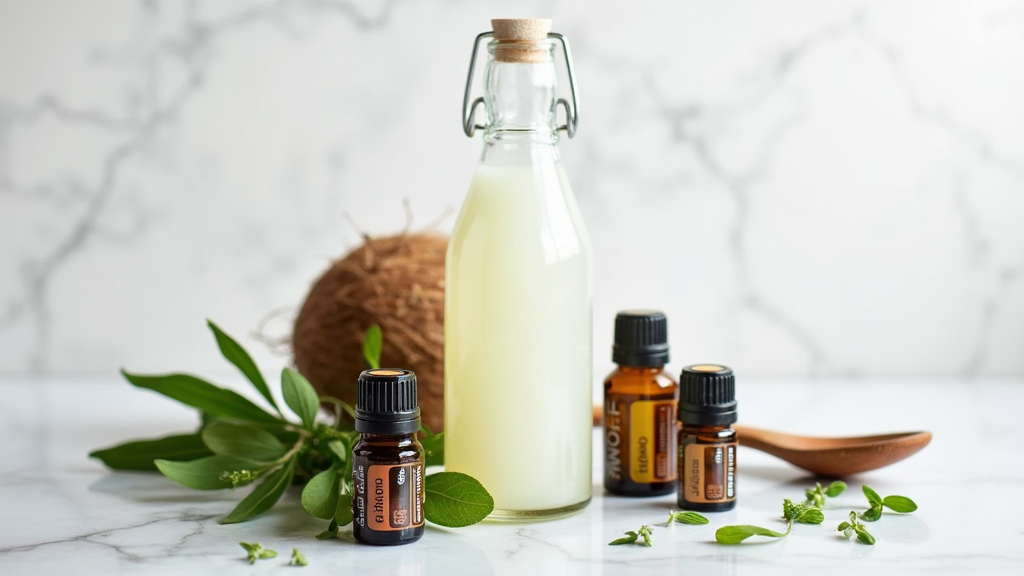If you’re into essential oils or natural beauty routines, you’ve probably seen fractionated coconut oil pop up again and again. It’s a favorite for all sorts of DIY blends, skincare recipes, and even massage oils, mainly because it’s light, non-greasy, and helps essential oils mix and absorb nicely. Here’s a super detailed guide on how to use fractionated coconut oil with essential oils safely and effectively, plus why it’s become a go-to carrier oil for people who love creating their own natural wellness blends.

What Is Fractionated Coconut Oil?
Fractionated coconut oil is basically regular coconut oil that’s been processed to stay liquid at room temperature. The longchain fatty acids are removed, leaving behind only the mediumchain triglycerides, which gives it a much lighter consistency than virgin coconut oil. This lighter consistency makes it really handy for things like aromatherapy, topical blends, and even homemade hair treatments. Because it’s so versatile, you’ll track down fractionated coconut oil in many commercial formulations, too.
The oil is totally clear and odorless, and it won’t clog pores. This is why it’s such a smart pick for sensitive skin types or anyone wanting to avoid heavy, greasy products. Since it doesn’t go rancid quickly thanks to its high stability, it’s perfect if you like to make batches of DIY stuff to keep on hand without worrying about spoilage. Fractionated coconut oil also washes out of fabrics more easily than thicker, solid coconut oil, making cleanup a breeze after treatments or massage sessions.
Why Use Fractionated Coconut Oil with Essential Oils?
Essential oils are super concentrated and strong, so you shouldn’t apply them directly to your skin. Carrier oils like fractionated coconut oil help dilute essential oils, letting you enjoy all the benefits safely. Below are a few reasons this oil stands out when paired with essential oils:
- Fast absorption: It soaks into the skin quickly, so your blends won’t sit on the skin or rub off on clothes.
- Non greasy feel: Unlike some heavier oils, it leaves the skin soft without any sticky residue.
- No odor: With no scent of its own, it lets your essential oils shine, making it easy to craft blends that smell just how you want.
- Stable and long-lasting: It doesn’t oxidize quickly, so your blends stay fresher longer and don’t need to be replaced as often.
This all makes fractionated coconut oil one of the most userfriendly, reliable carrier oils for both beginners and experienced essential oil fans alike.
Basic Steps for Mixing Fractionated Coconut Oil and Essential Oils
Making your own blends is really pretty simple, and it helps to follow a few simple steps to get dependable results. Here’s how you can mix things up safely and effectively:
- Pick Your Essential Oils: Choose oils based on the benefits or scents you want. For relaxation, lavender is classic, while peppermint brings a refreshing tingle.
- Select a Clean Container: Try to use glass bottles. Amber or cobalt blue bottles block UV light, which keeps your blend fresher longer.
- Decide on Dilution: The usual guideline for adults is a 2-3% dilution (12-18 drops of essential oil per ounce, or 30ml, of fractionated coconut oil). Kids and those with sensitive skin should stick to 1% dilution or less.
- Add Essential Oils First: This makes it easier to count the drops and keep track of your proportions.
- Top Up with Fractionated Coconut Oil: Slowly pour in the carrier oil, put on the cap, and give your bottle a gentle shake to mix.
A small funnel or dropper can help make the process less messy. Always label what you’ve made, noting the essential oils and the creation date for easy tracking.
Simple Uses for Fractionated Coconut Oil and Essential Oils
This combo is good for much more than just massages. Using fractionated coconut oil, here are some popular ways to put your blends to good use:
- Massage Oil: Add a few drops of essential oil (like lavender or eucalyptus) to several tablespoons of fractionated coconut oil to soothe sore muscles.
- Skin Moisturizer: Mix in rose or frankincense essential oils for a nourishing face or body moisturizer, especially after cleansing.
- Roller Bottles: Make personalized roller blends for stress, focus, or headaches. Fill a 10ml roller bottle with fractionated coconut oil and the right amount of essential oil for your needs.
- After Sun Care: Blend with lavender and peppermint oils for a cooling, refreshing rub post sun exposure.
- Hair Treatments: Add rosemary or tea tree oil to create a scalp massage oil that helps support healthy hair and soothes dryness.
- Makeup Remover: A simple mix with a drop or two of gentle essential oils makes for a soft, skin-loving makeup remover.
The more you use these combinations, the more likely you’ll stumble upon your own favorites for everyday self-care.
Common Ratios and Safety Tips
Diluting essential oils isn’t just for safety; it can actually make your blends more effective. Too much essential oil can irritate skin or cause allergies, so go easy, especially if you’re new to essential oils.
- 1% dilution: 6 drops of essential oil per 1 ounce (30 ml) carrier oil (best for kids, the elderly, or sensitive skin)
- 2% dilution: 12 drops per 1 ounce carrier oil (classic for most adult everyday use)
- 3% dilution: 18 drops per 1 ounce carrier oil (good for spot uses, like sore muscles for a shorter time)
Don’t forget a patch test before full use; try your new blend on your inner forearm and watch for redness, burning, or itching. If you see a reaction, wash it off and either add more carrier oil or discontinue use. For babies, pregnant women, or people with health issues, get professional advice before trying essential oils.
I’m posting a link to the FCO (fractionated coconut oil) that I like using:
“Here’s a little transparency: Our website contains affiliate links. This means if you click and make a purchase, we may receive a small commission. Don’t worry, there’s no extra cost to you. It’s a simple way you can support our mission to bring you quality content.”
Common Mistakes When Using Fractionated Coconut Oil with Essential Oils
Here are some common slip-ups to avoid:
- Using plastic bottles: Some essential oils can break down plastics. Stick with glass for safety and longevity.
- Skipping the patch test: Easy to skip but important, especially if you have sensitive skin or are using a new oil.
- Not labeling blends: Over time, it’s tough to keep track of what’s in each bottle. Clear labels with dates help avoid confusion.
- Overdoing essential oils: More isn’t always better. High concentrations can irritate the skin or cause sensitivities down the road.
Specific Blending Ideas To Get You Started
Check out a few tried-and-true blends using fractionated coconut oil as the base:
- Stress Support Roll-On: 6 drops lavender, 2 drops bergamot, 2 drops frankincense in a 10 ml roller bottle; fill with fractionated coconut oil and roll onto temples or wrists as needed.
- Soothing Muscle Rub: Mix 4 drops peppermint, 4 drops eucalyptus, 2 drops rosemary with one ounce of fractionated coconut oil—massage onto muscles after a long day.
- Glowing Skin Serum: Combine 2 drops geranium, 2 drops frankincense, 2 drops lavender in a tablespoon of fractionated coconut oil for a nightly skin treat.
Feel free to experiment. Just remember to always use skin-safe oils and check for any cautions before applying near your face or other sensitive spots.
How Fractionated Coconut Oil Compares to Other Carrier Oils
Fractionated coconut oil may be trending, but other carrier oils have their own highlights too. Here’s a quick rundown of how fractionated coconut oil compares to some other favorites:
- Jojoba oil: Absorbs quickly and closely mimics the skin’s natural oils, but costs a bit more than coconut oil.
- Sweet almond oil: Lighter in feel and adds a touch of moisture, though the mild nutty aroma may not always be ideal for certain blends.
- Grapeseed oil: Lightweight like fractionated coconut oil, but has a slightly shorter shelf life and more noticeable scent.
- Olive oil: Offers deep moisture and richness but is heavier in texture and can leave the skin with a slight film.
If you’re after flexibility with little to no aroma, fractionated coconut oil is a solid pick, while almond or avocado oil is great for those harsher winter months or super dry skin.
Frequently Asked Questions
Question: Can I use fractionated coconut oil on my face with essential oils?
Answer: Absolutely. Since it’s light and unlikely to clog pores, it’s safe in most facial blends—just stick to gentle oils like lavender or frankincense and always do a spot test first.
Question: Does fractionated coconut oil smell like coconuts?
Answer: Not at all. It’s odorless, so your essential oils will shine through without competing scents.
Question: Is it safe to use this blend on kids?
Answer: Use very mild oils at a low dilution, usually 1% or less, and check that your oils are safe for children. When in doubt, consult a child-focused essential oil guide.
Question: Can I eat fractionated coconut oil with essential oils?
Answer: This guide is for topical and aromatic use only. Eating essential oils or blends should only be done under medical supervision, so always check with a healthcare professional before internal use.
Question: How long do homemade blends stay fresh?
Answer: Most blends using fractionated coconut oil last several months when stored properly, since the oil doesn’t spoil quickly. If you notice any odd smells or cloudiness, it’s time for a fresh batch.
Tips for Storing Your Oil Blends
Store blends in a cool, dark spot to keep them at their best—bathroom cabinets or makeup drawers are ideal. Use amber or cobalt glass bottles to block sunlight and stop your mix from breaking down. Watch for weird smells, cloudiness, or color changes; when in doubt, play it safe and whip up a new batch.
Mixing fractionated coconut oil with essential oils is a great way to boost your self-care routine and tap into the benefits of aromatherapy and natural beauty. With a little know-how and some basic tools, you can create blends that fit your lifestyle while keeping your skin and well-being in mind. So grab your oils, get started, and find your favorites as you go!
